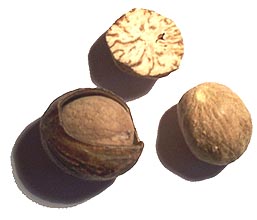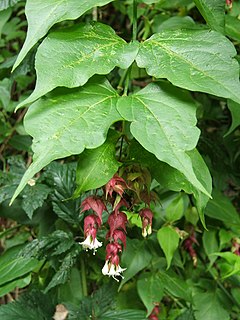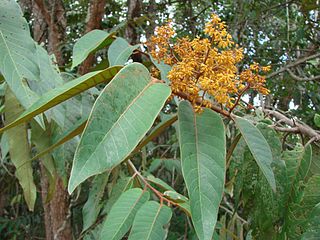
Nutmeg is the seed or ground spice of several species of the genus Myristica. Myristica fragrans is a dark-leaved evergreen tree cultivated for two spices derived from its fruit: nutmeg, from its seed, and mace, from the seed covering. It is also a commercial source of an essential oil and nutmeg butter. The California nutmeg, Torreya californica, has a seed of similar appearance, but is not closely related to Myristica fragrans, and is not used as a spice. Indonesia is the main producer of nutmeg and mace.

Myristicin is a naturally occurring compound found in common herbs and spices, the most well known being nutmeg. It is an insecticide, and has been shown to enhance the effectiveness of other insecticides in combination. Myristicin is also a precursor for substituted amphetamine derivative compounds structurally related to MDMA; it is believed to be metabolized into MMDA in the body to produce hallucinogenic effects, and can be converted to MMDMA in controlled chemical synthesis. It interacts with many enzymes and signaling pathways in the body, is cytotoxic to living cells, and may also have chemoprotective properties.

Nutmegger is a nickname for people from the US state of Connecticut. The official nickname for Connecticut is "The Constitution State", as voted in 1958 by the Connecticut state legislature; however "The Nutmeg State" is an unofficial nickname for the state, hence the nickname "Nutmegger".
Nutmeg oil is a volatile essential oil from nutmeg. The oil is colorless or light yellow and smells and tastes of nutmeg. It contains numerous components of interest to the oleochemical industry. The essential oil consists of approximately 90% terpene hydrocarbons. Prominent components are sabinene, α-pinene, β-pinene and limonene. A major oxygen-containing component is terpinen-4-ol. The oil also contain small amounts of various phenolic compounds and aromatic ethers, e.g. myristicin, elemicin, safrole and methyl eugenol. The phenolic fraction is considered main contributor to the characteristic nutmeg odor.
Myristic acid (IUPAC systematic name: 1-tetradecanoic acid) is a common saturated fatty acid with the molecular formula CH3(CH2)12COOH. Its salts and esters are commonly referred to as myristates or tetradecanoates. It is named after the binomial name for nutmeg (Myristica fragrans), from which it was first isolated in 1841 by Lyon Playfair.

The Myristicaceae are a family of flowering plants native to Africa, Asia, Pacific islands, and the Americas and has been recognized by most taxonomists. It is sometimes called the "nutmeg family", after its most famous member, Myristica fragrans, the source of the spices nutmeg and mace. The best known genera are Myristica in Asia and Virola in the Neotropics.
1-Tetradecanol, or commonly myristyl alcohol (from Myristica fragrans – the nutmeg plant), is a straight-chain saturated fatty alcohol, with the molecular formula C14H30O. It is a white crystalline solid that is practically insoluble in water, soluble in diethyl ether, and slightly soluble in ethanol.

Leycesteria formosa, the Himalayan honeysuckle, flowering nutmeg, Himalaya nutmeg, granny's curls or pheasant berry, is a deciduous shrub in the family Caprifoliaceae, native to the Himalaya and southwestern China. It is considered a noxious invasive species in Australia, New Zealand, the neighbouring islands of Micronesia, and some other places.
Nutmeg is a spice, usually obtained from the plant Myristica fragrans. It may also refer to:

Carya myristiciformis, the nutmeg hickory, of the Juglandaceae or walnut family, also called swamp hickory or bitter water hickory, is found as small, possibly relict populations across the Southern United States and in northern Mexico on rich moist soils of higher bottom lands and stream banks. Little is known of the growth rate of nutmeg hickory. Logs and lumber are sold mixed with other hickories. The nuts are an oil-rich food for wildlife.

The barking imperial pigeon, also known as Peale's imperial pigeon, is a species of bird in the pigeon family Columbidae. It is endemic to Fiji, where it occurs on most of the medium and large islands.

Monodora myristica, the calabash nutmeg, is a tropical tree of the family Annonaceae or custard apple family of flowering plants. It is native to Angola, Benin, Cameroon, the Central African Republic, the Democratic Republic of the Congo, Equatorial Guinea, Gabon, Ghana, Guinea-Bissau, Ivory Coast, Kenya, Liberia, Nigeria, the Republic of the Congo, Sierra Leone, Sudan, Tanzania, Togo and Uganda. In former times, its seeds were widely sold as an inexpensive nutmeg substitute. This is now less common outside its region of production. Other names of calabash nutmeg include Jamaican nutmeg, African nutmeg, ehuru, ariwo, awerewa, ehiri, airama, African orchid nutmeg, muscadier de Calabash and lubushi.

Monodora is a genus of plant in family Annonaceae. It contains approximately 15 species, distributed throughout tropical Africa.
Myristica cinnamomea is a species of plant in the Myristicaceae (Nutmeg) family. It is found in Sumatra, Peninsular Malaysia, Singapore and Borneo.

Myristica globosa is a species of plant in the family Myristicaceae. It is found in Papua New Guinea the Solomon Islands and Australia.

Myristica malabarica is a species of plant in the family Myristicaceae. It is endemic to the Western Ghats in southwest India. It is threatened by habitat loss according to the IUCN Red List. It can reach up to 25 m long and its bark is greenish black, smooth and sometimes reddish.
Myristica sinclairii is a species of nutmeg. It is endemic to Papua New Guinea.

Virola sebifera is a species of tree in the family Myristicaceae, from North and South America.

Myristica fragrans is an evergreen tree indigenous to the Moluccas of Indonesia. It is important as the main source of the spices nutmeg and mace. It is widely grown across the tropics including Guangdong and Yunnan in China, Taiwan, Indonesia, Malaysia, Grenada in the Caribbean, Kerala in India, Sri Lanka and South America.

Macelignan (Anwulignan) is a lignan. It can be found in Myristica fragrans, the nutmeg.












